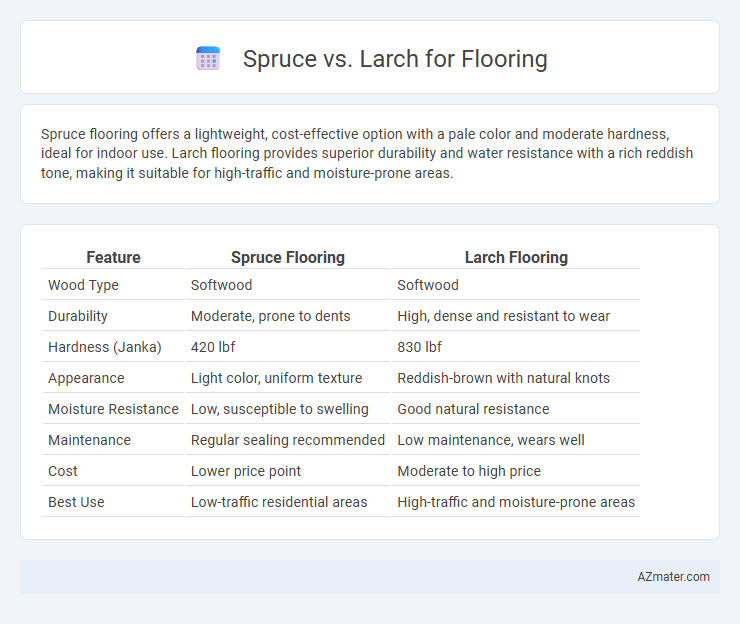Spruce flooring offers a lightweight, cost-effective option with a pale color and moderate hardness, ideal for indoor use. Larch flooring provides superior durability and water resistance with a rich reddish tone, making it suitable for high-traffic and moisture-prone areas.
Table of Comparison
| Feature | Spruce Flooring | Larch Flooring |
|---|---|---|
| Wood Type | Softwood | Softwood |
| Durability | Moderate, prone to dents | High, dense and resistant to wear |
| Hardness (Janka) | 420 lbf | 830 lbf |
| Appearance | Light color, uniform texture | Reddish-brown with natural knots |
| Moisture Resistance | Low, susceptible to swelling | Good natural resistance |
| Maintenance | Regular sealing recommended | Low maintenance, wears well |
| Cost | Lower price point | Moderate to high price |
| Best Use | Low-traffic residential areas | High-traffic and moisture-prone areas |
Introduction: Spruce vs Larch Flooring
Spruce and larch are popular softwood options for flooring, valued for their natural beauty and durability. Spruce offers a light, uniform color with a fine grain, making it ideal for bright, modern interiors, while larch features a distinct reddish hue and pronounced grain patterns that add rustic warmth. Both woods provide solid performance, but larch tends to be denser and more resistant to wear, influencing long-term flooring choices.
Wood Characteristics: Spruce and Larch
Spruce flooring offers a light color with a fine, uniform grain that provides a smooth texture, making it ideal for bright, minimalist interiors. Larch wood features a distinctive, rich reddish-brown hue with pronounced grain patterns and dense resin canals, contributing to superior durability and natural resistance to moisture. Both woods are softwoods, but Larch's higher density and natural oils make it more suitable for high-traffic areas and environments prone to humidity.
Durability and Strength Comparison
Spruce flooring offers lighter, more flexible wood with moderate durability, ideal for indoor spaces with less foot traffic, while larch provides superior strength and hardness due to its dense resin content, making it highly resistant to wear and impact. Larch's enhanced durability withstands heavy loads and moisture better than spruce, ensuring longer-lasting floors in high-traffic or damp environments. Choosing larch over spruce significantly improves flooring resilience, reducing maintenance and extending lifespan.
Appearance and Aesthetic Appeal
Spruce flooring offers a light, creamy color with subtle grain patterns, providing a clean and modern aesthetic ideal for minimalist or Scandinavian-inspired interiors. Larch flooring displays rich, warm tones with pronounced knots and a varied texture, adding rustic charm and character to traditional or cabin-style spaces. The choice between spruce and larch depends on the desired ambiance, with spruce emphasizing sleek simplicity and larch offering a more rugged, natural look.
Resistance to Moisture and Wear
Spruce flooring offers moderate resistance to moisture but tends to absorb water more readily, making it less ideal for high-humidity environments compared to larch. Larch wood exhibits superior durability and natural resistance to moisture due to its dense grain and high resin content, enhancing its wear resistance in flooring applications. Choosing larch over spruce significantly improves the longevity and performance of flooring in areas prone to dampness and heavy foot traffic.
Installation Considerations
Spruce flooring offers ease of installation due to its lightweight nature and consistent grain pattern, which allows for smooth cutting and fitting. Larch, being denser and harder, requires sturdier tools and more precise handling to avoid splitting during installation. Both woods benefit from acclimation to indoor humidity levels before installation to prevent warping and ensure long-term stability.
Maintenance and Care Requirements
Spruce flooring demands regular sealing and gentle cleaning to prevent surface wear and moisture damage due to its softer wood fibers. Larch offers enhanced durability with higher resin content, reducing the frequency of maintenance and providing better resistance to scratches and dents. Both woods benefit from prompt spill cleanup, but larch's natural water-resistant properties make it more suitable for high-traffic or moisture-prone areas.
Cost and Availability
Spruce flooring generally costs less than larch due to its widespread availability and faster growth rate, making it a budget-friendly option for large projects. Larch, with its denser composition and natural resistance to decay, commands higher prices and is less readily available in some regions, influencing overall material costs. Both woods vary in pricing based on local supply chains, but spruce remains more accessible and economical for flooring purposes.
Eco-Friendliness and Sustainability
Spruce flooring offers renewable and fast-growing wood that is harvested from well-managed forests, contributing to its eco-friendliness. Larch wood, known for its natural durability and resistance to decay, reduces the need for chemical treatments, enhancing its sustainability profile. Both Spruce and Larch support sustainable construction practices, but Larch's longer lifespan can result in less frequent replacement and reduced environmental impact over time.
Best Applications: Choosing the Right Wood
Spruce offers a lightweight, cost-effective option ideal for interior flooring in low-traffic areas due to its soft texture and pale color. Larch provides superior durability and resistance to moisture, making it well-suited for high-traffic spaces and environments exposed to humidity or outdoor elements. Selecting between spruce and larch depends on balancing aesthetic preferences with the flooring's functional demands and expected wear.

Infographic: Spruce vs Larch for Flooring
 azmater.com
azmater.com